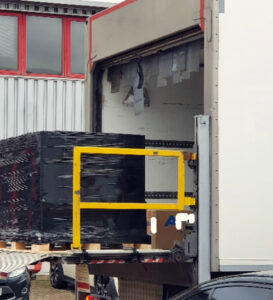THE FACE
OF YOUR COMPANY?THE FACE OF YOUR COMPANY?
Why delivery driver training is so much more than just going from A to B
June 2021


Shahbaz Sarwar
Director and Senior Consultant
“Be the face of something”
Definition: to represent the nature or character of an organization, industry, system etc, and the way it appears to people.
For Pharmaceutical Wholesalers, your truck delivery isn’t just a vital link in your chain, it is often one of the primary customer facing links of that chain. Vehicle and product handling are key to that, and the driver is the person upon whom your reputation hangs.
- Does your driver represent the nature and character of your organisation?
- Does your driver represent the organisational systems and vision?
- Does your driver represent the organisational values of putting the patient first?
- Does your driver represent the quality of your organisation?
If you cannot confidently answer yes to all the above questions, this article will reveal real-life bad practices and how they can have a detrimental effect on your reputation and future income. I also offer some helpful suggestions and thoughts to reduce these risks and allow you to operate with greater confidence.
Example 1 – temperature excursion
In my former role as an MHRA GDP Inspector, I remember clearly an inspection at a production facility. Whilst in the yard, I was able to observe a driver returning from performing deliveries. I observed the final process of the journey which involved obtaining the temperature printout for the whole journey, completing a checklist for the vehicle confirming loading area is empty as well as returning any remaining products plus general checks of the vehicle.
As I reviewed the journey temperature printout, I could see that there was a long period of time when the temperature specifications were outside the storage temperature range. This excursion had not been acknowledged and, when the driver was asked, he confirmed that the alarm mute button had not been reset in the vehicle cabin. So potentially a number of products had been delivered with an impact on product quality due to this temperature excursion.
This episode resulted in a large investigation into the products affected which involved contacting the customer, getting products returned, replacement products supplied, subsequent assessment and potential destruction of stock.
- Was the company represented in a positive nature to the customer?
- Why was the system designed to be reliant on resetting the alarm mute button?
- Why is there no driver training, on the importance of maintaining medicinal products labelled conditions and the driver responsibilities in the supply chain?
- Why was there no process in place for driver checks prior to loading the vehicle?
There was no specific training in place for the driver to help educate him about the critical nature of elements of his role. The only thing available was annual GDP training.
Example 2 – poor equipment
The picture below shows a delivery of palletised temperature-controlled medicinal products in a temperature-controlled vehicle.

The image begs some serious questions:
- Do you think the driver understands the role and importance of the plastic curtains in maintaining temperatures?
- Is he bothered that these are damaged and rolled-up?
- How many other vehicles are being operated by the wholesaler in the same way?
- Is the company compliant?
There are many more examples of poor GDP compliance when it comes to deliveries being received. If I were a customer of either of the above deliveries, I would not have a very good impression of the level of compliance and understanding of the GDP guidelines to say the least. The potential implications for the supplier are obvious – loss of a customer, regulatory inspection if bad practises are being observed, increase in complaints, returned stock, and reputational damage.
Conclusions
As part of the GDP guidelines all personnel involved in wholesale distribution activities should be trained on the requirements of GDP. They should have the appropriate competence and experience prior to commencing their tasks.
As a wholesale distributor are your drivers competent and does your training in GDP also educate the driver?
More importantly, is the investment in the training and competence being demonstrated?
Or maybe there is insufficient investment in the training and developing competence of your delivery drivers.
Why is delivery driver training not performed effectively?
There can be a number of reasons and these can be linked to:
- What is seen as acceptable in the company culture.
- Lack of understanding/oversight of the driver’s role in wholesale distribution activities.
- Maintenance of training is difficult due to high turnover of drivers.
- Use of temporary drivers.
- Transport is outsourced and responsibility for training lies with the service provider.
Hopefully this article has helped you to look at the training requirements of your delivery drivers as more than just a regulatory inconvenience. Their role is not just the final cog in your production and distribution, they are a critical face of your company. Are they fulfilling that role?
SeerPharma UK offer a range of training courses as well as bespoke training. Visit our training page for more details or contact us directly for more information about how we can help.
Sign up for our regular communications
It’s all here, from must-read articles, savings on training to being the first to know about new courses… of course you need to know!
